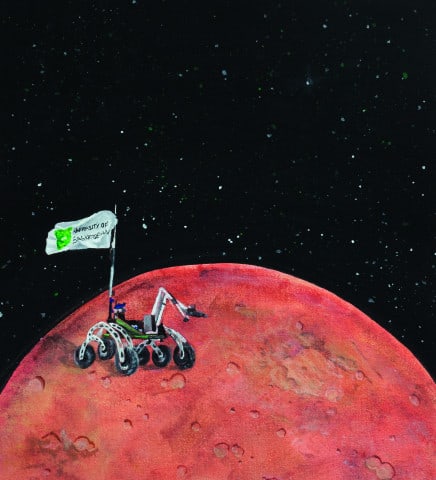Beating out 24 teams from across the globe, including only one other Canadian competitor from McGill University, the University of Saskatchewan Space Design Team built a winning Mars rover and claimed top prize at the international level on Sept. 6.
The European Rover Challenge is the biggest space and robotics open-air event in Europe. The ERC hosted its second competition in Poland this year and included teams from the United States, Colombia, Bangladesh and India, among others. Each team had to build a robot that would compete in simulated navigational, geological and field Mars tasks geared towards helping astronauts in need while on the Red Planet.
Four USST members travelled to Poland to represent the U of S and present their version of the Mars rover. A student and alumni group dedicated to the development of next generation space technologies, the USST formed in 2005 and the team has since been working on a variety of projects, many of which have received international recognition.
Austin Shirley, U of S computer engineering undergraduate student and USST vice-president engineering, admits he was surprised at how well the team placed.
 “I would say by no means that we had the absolute best rover there. There were some teams with some really cool designs and really cool ways of approaching things that we never even thought of, but we had a team that was really intimately familiar with how the design works and a team that was really good at working together at fixing all the problems,” Shirley said.
“I would say by no means that we had the absolute best rover there. There were some teams with some really cool designs and really cool ways of approaching things that we never even thought of, but we had a team that was really intimately familiar with how the design works and a team that was really good at working together at fixing all the problems,” Shirley said.
Approximately 20 USST members were involved in the production of the Mars rover, including students from varying disciplines such as commerce, social sciences, computer science and biology. Shirley insists that anyone can join the USST and all students are welcome. For Shirley, the USST has the ability to shape people.
Jack Fotheringham, USST president, agrees with Shirley and speaks to the practical experiential learning gained by working with the student group.
“It’s very independent and we don’t have a lot of oversight; we do have to figure out a lot of things ourselves and I think ultimately that’s a really good thing,” Fotheringham said.
Both Shirley and Fotheringham recognize the significance of their experience with the USST and speak to the unique learning that accompanies their respective roles.
“The USST, at least from the operational side, is a lot like a small business. We don’t sell a product, really, although you could conceptualize it that way. We run off sponsorships and donations and those sorts of things, but we operate on probably a $90,000 annual budget and we probably end up spending about $40–50 thousand a year, it is pretty substantial,” Fotheringham said.
Shirley points out that the budget may seem steep but when it comes to space innovation and research, the ability to access appropriate resources or materials does not come cheap.
“A lot of our funding is through personal donations, alumni donations, corporate sponsors and the U of S president’s office, but a lot of what we use are custom built, one-off prototypes, so they can get very expensive,” Shirley said.
Thanks to the generosity of its donors, the USST were able to put forth their best prototype yet at this year’s ERC, claiming the top prize along with bragging rights.
“We did have a few innovative technologies — like weight — we built our rover chassis this year out of carbon fibre, which is pretty unique for this type of student challenge. We were able to do an innovative approach that incorporated 3D printing and manufactured carbon fibre to allow us to do a professional frame in a lot less time than usual,” Shirley said
The rover took approximately one year for the USST to design. The team members compare it to designing a car, explaining that it is a complex system that requires a lot of work.
“It is entirely unique, completely custom designed. We have some pre-manufactured components but even our embedded computers are programmed by us,” Fotheringham said.
Despite the complexities of the work involved in creating an internationally revered Mars rover, Shirley encourages interested U of S students to get involved no matter their area of study.
“We were all first year students at one time, we didn’t know anymore than any other high school student and if you think ‘Hey, I am studying music and I’ve got nothing to give to a robotics design team,’ you might be surprised at how much skill you actually have and how much you can learn.”
—
Image: Jeremy Britz/Graphics Editor